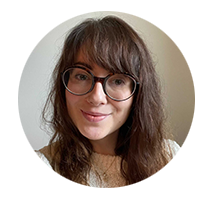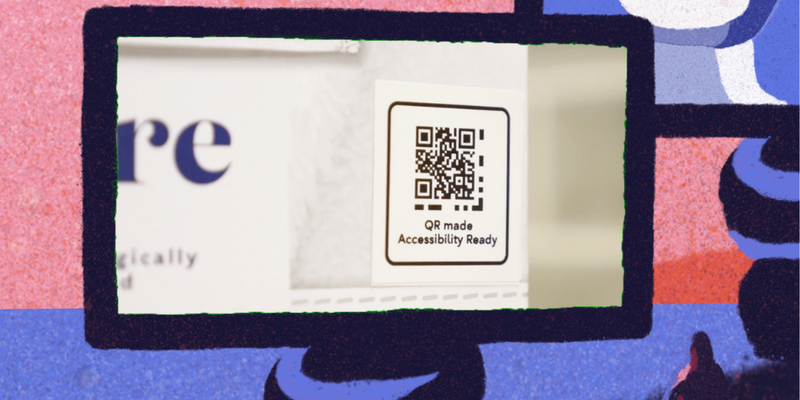“It should just be a basic human right, that everyone should have access to product information on packaging, that should not be about your visual acuity. It should just be a problem we can solve, and thankfully we can solve it through tech.” - Caspar Thykier (Zappar CEO & Co-Founder)
This is why Zappar have been working alongside our partners at Unilever to roll out Zapvision and ‘Accessible QR’, a cutting-edge computer vision technology and code system designed to help the blind and partially sighted easily access information from products on supermarket shelves and cupboards at home via their smartphone.
What is Accessible QR?
'Accessible QR' is the next-generation of QR code that creates one code scheme for your product packaging or signage that can be accessed by everyone, no matter their visual acuity.
Using any app featuring our Zapvision SDK, our patent pending D3 code schemes takes your existing QRs and gives them a new accessibility layer, meaning that a simple addition to the existing artwork and workflow can make a world of difference to the blind and partially sighted community with minimal cost.
Embarking on the ‘Accessible QR’ journey with Unilever
During our AR Pioneers event in November, we were joined by our partners at Unilever, Sarah Masters (Digital Transformation Director) and Mark Hewitt (Brand and Digital Transformation) to talk all about our ‘Accessible QR’ journey.
The problem
For Sarah and Mark, it was working within the cross-departmental connected packaging team that brought the issue of accessibility into focus. The team within Unilever responsible for “understanding the agenda, the needs and the accessibility problems that we're trying to solve” saw the potential in the connected packaging initiative as part of the accessibility solution.
Leading on from this the team started to work with the RNIB and similar associations to listen to the community and uncover the challenges that face the blind and visually impaired both when shopping in the outside world and navigating products at home.
To find out that people that have huge accomplishments in their life, haven't been supported to pick up a bottle of bleach and use it safely or pick up some food and be told if it has an allergen that they have , because if you're blind, you might also have allergies and if you're blind you also wash clothes...how can we answer this problem?” - Sarah Masters
It became a “passion project” for Sarah and Mark looking to join all the pieces together to find an answer to this problem. Taking it upon themselves to listen and learn over months (and years) to really understand the problem and explore different solutions.
Why Zapvision and Accessible QR?
There are a number of different solutions out there working to solve the problem of accessibility, some very successfully. During our talk, Sarah and Mark were kind enough to share with us what factors were important to a large company like Unilever, when choosing a solution and how Zapvision and ‘Accessible QR’ fit into that.
1. Not disrupting brand real estate
One of the biggest challenges facing brands is packaging doesn’t have a lot of spare real estate and “even if you have the best intentions in the world, there's only so much space” to add more digital signposts. From a commercial point of view if you are going to have to start reducing your logo size and other important elements of branding an accessibility solution becomes less appealing.
If the QR is already on pack to reach the majority of consumers and provide a digital springboard, then you don’t want to add competing digital signatures. By using 'Accessible QR' everything you need is in one place, keeping the packaging simple, streamlined and most importantly fully branded.
“It's genius, because the QR code is happening anyway, and if that's already going out, as we said this year, on billions of items, why not ride that wave?” - Sarah Masters
2. Cost-effectiveness
Similarly to protecting branding real estate the commercial angle comes into play again when it comes to cost. You want to be adding to the production cost as little as possible and using ‘Accessible QR’ gives brands the ability to “print simply with two colors, pulling down cost, making this highly palatable.” Something that for Unilever was already set up within the Connected Pack program.
3. Ease of implementation
What better way to pitch an accessibility solution than not needing to pitch it at all?
“What makes it ('Accessible QR') really interesting is, it means you don't actually have to talk to brands about the rollout of accessibility because accessibility is just built into the QR code program.” - Sarah Masters
By making the application part of an existing benefit, digitizing packaging, accessibility becomes an “opt-out, not an opt-in.” The solution is rolled in without extra effort or space.
“Which is how it should be. It shouldn't be an add-on. It should just be part of the experience that we're giving all of our consumers.” - Sarah Masters
4. Integration into existing apps
When working across multiple different markets, 120 in Unilever’s case, brands have a responsibility to be able to address consumers in each of those markets. Trying to build and support a single app for this one use case across all markets would be costly and less relevant to the community.
“So having something that could be integrated into existing apps that reflect the top two or three apps in any given market would seem a really simple and neat way of dealing with this.” - Mark Hewitt
Final thoughts
“If you do have the QR code on pack and you have the solution as neat and effective as this, I don't think we have the right to say, ‘no, let's not make it accessible’.” - Sarah Masters
This is what ‘Accessible QR’ is all about. Providing a simple, cost-effective and inclusive solution that takes out the cost, complexity and operational hurdles and makes it easy for everyone to opt-in. Utilizing connected packaging, that is already proven to provide commercial and brand benefit to make sure that all of a brand's consumers can have a positive experience and access the information they need.
Is it the perfect solution, no. “Accessibility means so many things to so many people,” so it's impossible to get it exactly right. But the key takeaway we have from Unilever is that it shouldn't stop you: these things need to start somewhere and brands now have an opportunity and arguably a responsibility to make sure that they are thinking about solutions that can make real world differences to millions of people's everyday lives.
Speak to us about Zapvision and Accessible QR
If you’d like to learn more about Zapvision and how you can enable 'Accessible QR' for your brand or business, please reach out to us via the contact form or email us at contact@zappar.com
 Grace Vassallo
Grace VassalloSenior Brand & Marketing Manager, Zappar
